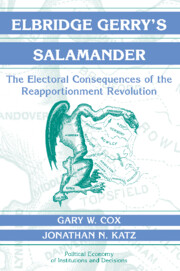Book contents
- Frontmatter
- Contents
- List of Tables and Figures
- Preface
- Part I Introduction
- Part II Democrats and Republicans
- Part III Incumbents and Challengers
- 8 The Growth of the Incumbency Advantage
- 9 Candidate Entry Decisions and the Incumbency Advantage
- 10 Redistricting and Electoral Coordination
- 11 Redistricting, the Probability of Securing a Majority, and Entry
- 12 Reassessing the Incumbency Advantage
- Part IV Conclusion
- References
- Author Index
- Subject Index
- Titles in the series
11 - Redistricting, the Probability of Securing a Majority, and Entry
Published online by Cambridge University Press: 10 November 2009
- Frontmatter
- Contents
- List of Tables and Figures
- Preface
- Part I Introduction
- Part II Democrats and Republicans
- Part III Incumbents and Challengers
- 8 The Growth of the Incumbency Advantage
- 9 Candidate Entry Decisions and the Incumbency Advantage
- 10 Redistricting and Electoral Coordination
- 11 Redistricting, the Probability of Securing a Majority, and Entry
- 12 Reassessing the Incumbency Advantage
- Part IV Conclusion
- References
- Author Index
- Subject Index
- Titles in the series
Summary
I’m [not running for reelection]. It reflects a lack of confidence on my part thatwe’ll be a majority party in the House any time soon.
Rod Chandler (R-Washington) (quoted in Ansolabehere and Gerber 1997)In Chapter 8, we showed that the incumbency advantage (as measured by the standard methodology) tended to be larger for Republicans than for Democrats after the mid-1960s. In this chapter, we seek to explain this and other party differences.
In outline, our argument is as follows. First, the abrupt disappearance of pro-Republican bias in the translation of congressional votes into congressional seats (outside the South) led to an abrupt structural decline in the short- and medium-term probability that the Republicans would be able to secure a majority in the U.S. House of Representatives. This decline in the Republicans' chances of securing a majority raised the expected value of a House seat for Democrats but depressed it for Republicans, leading to a syndrome of entry and selection effects that, among other things, explain the party differences uncovered in Chapter 8.
The rest of the chapter proceeds as follows. The first section outlines a simple model of a candidate's decision to enter a House race. We then use that model to explain why candidates of the two parties should have had different valuations of a House seat and how the valuation gap evolved over the post-World War II era. The key variable in this discussion is the probability that each party would secure a majority in the House. The third section explains the consequences that should have followed as the valuation gap rose and fell. We then test these predictions, discuss our findings, and conclude.
the decision to enter
Consider a candidate deciding whether to enter a race for a House seat.
Information
- Type
- Chapter
- Information
- Elbridge Gerry's SalamanderThe Electoral Consequences of the Reapportionment Revolution, pp. 172 - 193Publisher: Cambridge University PressPrint publication year: 2002
